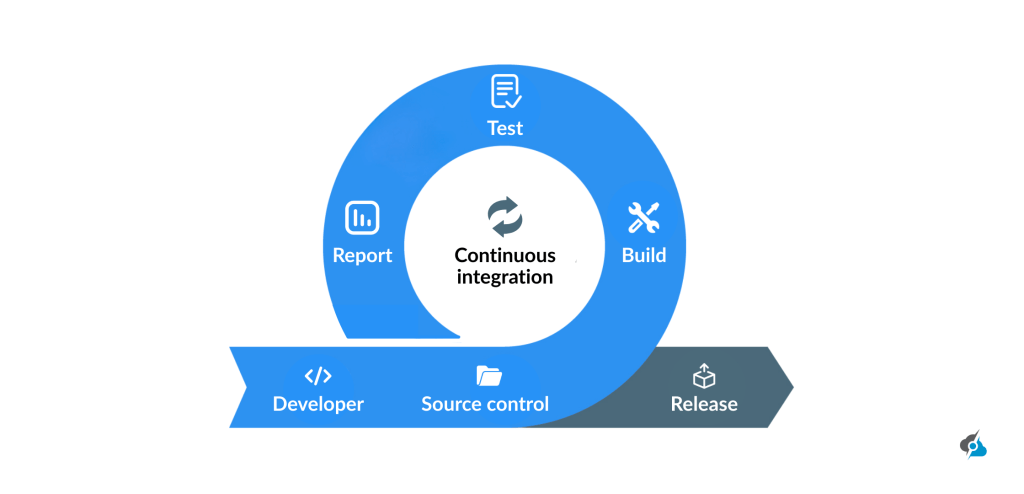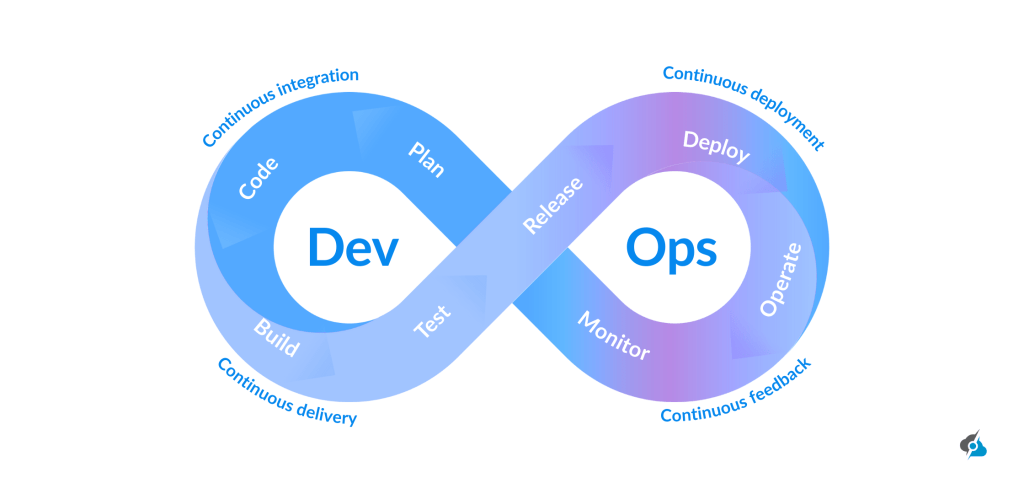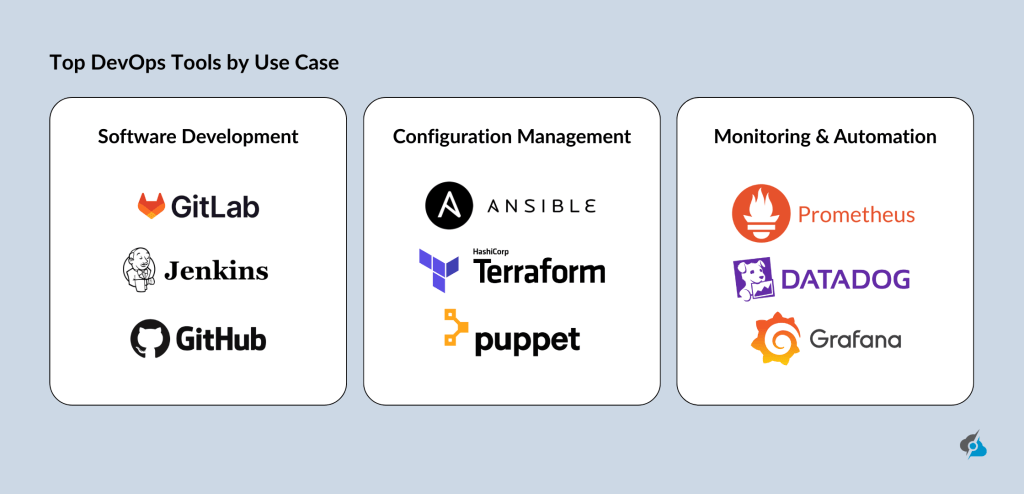The 10 Best DevOps Tools in 2025

In 2025, efficient DevOps practices are vital for streamlining collaboration and delivery in the software development process, relying on tools that boost efficiency.
At ServerMania, a trusted cloud hosting leader since 2008, we leverage our expertise in production, staging and development to empower development infrastructure management with popular DevOps tools.
In this article we’ll highlight the top tools driving developer process integration and open and broad integration for modern workflows.
Introduction to DevOps Tools
DevOps is all about bringing developers and operations teams together, motivating teamwork, clarity, and trust to build, test and deploy software quickly. There are many crucial DevOps tools make the app development lifecycle seamless, uniting teams to deliver better code.
These popular tools are the foundation, smoothing out automation, integration, and scaling across teams. They tackle communication walls and keep the software delivery pipeline flowing forward.
Here’s what to keep in mind when selecting the right tools:
- Platform Compatibility: Ensure those management tools align with your software systems and infrastructure, supporting cloud, on-premises, or hybrid development environments.
- Workflow Integration: Confirm tools integrate smoothly with existing IDEs, coding platforms, and project management systems for efficient collaboration.
- Pipeline Connectivity: Select tools that connect with CI/CD pipelines, testing frameworks, and communication platforms to maintain seamless operations.
- Usability and Scalability: Choose tools that are intuitive to adopt and scale effectively as team expertise and organizational needs evolve.
- Cost and Licensing Evaluation: Assess open-source versus commercial tools, considering licensing and operational costs for clear budgeting.
The 10 Best DevOps Tools 2025
In 2025, essential DevOps tools drive continuous delivery, empowering teams to streamline application development, deployment and management.
Here’s a breakdown of our top 10 DevOps tools in 2025:
1. Git
Back in 2005, Linus Torvalds released Git, a free, open source tool that’ has proven to be a total game-changer for version control. It tracks changes, allowing group development on projects with ease. Git’s distributed version control system hands every coder their own full project copy right on their machine, making collaboration a breeze.

Main Git Features:
- Tracks change history for auditing and rollback.
- Free and open-source, reducing licensing costs.
- Non-linear development with parallel branches.
- Creates automatic backups for data integrity.
- Scales effortlessly for small to large projects.
- Enables distributed collaboration across teams.
Primary Use Cases:
- Collaborative development with distribution.
- Managing code for an open-source projects.
- Supporting CI/CD pipelines with deployments.
- Versioning configuration files in IaC workflows.
Git’s simplicity, scalability, and robust branching make it indispensable for DevOps in 2025, ensuring teams deliver code reliably and collaboratively.
2. Jenkins
Jenkins is an trusty open source automation tool born as Hudson in 2004, that break out in 2011 after splitting from Oracle. Written in Java, it’s the foundation of continuous integration and CI CD, making software development a easy by automating builds, tests, and deployments. Its controller-agent setup handles distributed builds professionally, keeping DevOps team’s workflow working error-free pipelines.

Main Jenkins Features:
- Automates the build, test, and deployment stages.
- Supports 1,800+ plugins for extensive integrations.
- Enables distributed builds via controller-agent model.
- Facilitates pipeline-as-code through the Jenkinsfile.
- Scales across on-premises, cloud, or containerized setups.
Primary Use Cases:
- Automating CI/CD for microservices with Kubernetes.
- Streamlining the testing for multi-language projects.
- Managing deployments across virtual environments.
- Supporting agile workflows with frequent code commits.
Jenkins’ plugin ecosystem and scalability are nailing down it’s place in our list, empowering teams to deliver reliable software swiftly.
3. Docker
Docker is a robust open source tool, launched back in 2013, that transforms software development by enabling containerization. It packages applications and dependencies into portable containers, which ensures seamless operation across development environments. With Docker installed, teams achieve consistent performance from development to production, making it a vital asset for virtual environments in modern DevOps workflows.

Main Docker Features:
- Packages applications with dependencies for portability.
- Ensures consistent environments across development stages.
- Supports Dockerfiles for automated container builds.
- Integrates with CI/CD and orchestration platforms.
- Scales efficiently with lightweight container technology.
Primary Use Cases:
- Streamlining microservices deployment in cloud sites.
- Ensuring consistent testing across hybrid setups.
- Simplifying application packaging for CI/CD pipelines.
- Supporting development of portable, cross-platform apps.
The Docker ability to accelerate and standardize application delivery earns its position as a top DevOps tool in 2025, empowering teams to deploy with confidence and speed.
4. Kubernetes
Since it’s introduction by Google in 2014, Kubernetes, or K8s, has been a well-known open software tool for container orchestration tool. It automates the deployment, and management of containerized apps, drawing on Google’s deep expertise in cloud environments. This robust platform is amongst the best DevOps deployment, nowadays adopted by many modern DevOps tasks/workflows.

Main Kubernetes Features:
- Automates deployment, scaling, and updates of applications.
- Ensures high availability through its self-healing and failover.
- Supports declarative configuration via YAML/JSON manifests.
- Kubernetes integrates with container runtimes like Containerd.
- Scales workloads across hybrid and multi-cloud environments.
Primary Use Cases:
- Managing microservices for scalable web-based applications.
- Running stateful apps like databases with PersistentVolumes.
- Fully automating the CI/CD pipelines with GitOps workflows.
- Deploying machine learning models in the production stages.
Kubernetes’ flexibility and ecosystem make it a top DevOps tool in 2025, empowering teams to manage complex, scalable applications with ease.
5. Terraform
Since its launch in 2014, Terraform, is an open source tool from HashiCorp, has redefined infrastructure as code for DevOps teams. It automates infrastructure provisioning and managing infrastructure across cloud and on-premises setups using clear, declarative HCL/JSON files. This powerful DevOps tool ensures consistent, readable configurations, making it a go-to for streamlined virtual environments in the modern workflows.

Main Terraform Features:
- Defines infrastructure with declarative HCL or JSON.
- Supports multi-cloud providers (AWS, Azure, GCP, etc.).
- Generates execution plans to preview changes safely.
- Enables reusable modules for standardized configurations.
- Tracks infrastructure state for consistent management.
Primary Use Cases:
- Provisioning virtual environments for fault-tolerant apps.
- Automating Kubernetes cluster setups on cloud platforms.
- Managing disposable test and staging environments.
- Enforcing policy compliance with Sentinel integration.
Terraform’s versatility and robust ecosystem solidify its role as a top DevOps tool in 2025, enabling teams to provision infrastructure efficiently and reliably.
6. Ansible
Since its 2012 release, Ansible has become an open source configuration management tool from Red Hat that simplifies workloads with YAML playbooks. It fully automates tasks like server setups and software deployment without pesky agents, making it a DevOps favorite. Its straightforward approach streamlines repetitive tasks across systems, ensuring efficient workflows in cloud services and beyond.

Main Ansible Features:
- Uses YAML playbooks for clear, readable automation.
- Agentless design that simplifies setup via SSH.
- Supports thousands of modules for diverse tasks.
- Integrates with CI/CD and revision control systems.
- Scales across on-premises and multi-cloud setups.
Primary Use Cases:
- Automating server provisioning for web applications.
- Managing cloud resources across AWS and Azure.
- Streamlining the network device configurations.
- Orchestrating CI/CD pipeline tasks with Jenkins.
Ansible’s straightforward vibe and flexibility make it a top DevOps pick in 2025, helping teams zap manual work and keep systems humming smoothly.
7. GitHub
Since its 2008 launch, GitHub, a dynamic cloud based platform, has transformed revision control with Git, enabling seamless collaboration for development departments.
It also serves as a central hub for managing code repositories, with GitHub Actions powering continuous delivery and pull requests streamlining code audit. Its project boards and issue trackers enhance task management, making it an essential.

Main GitHub Features:
- GutHub hosts Git repositories for revision control.
- Automates CI/CD with GitHub Actions workflows.
- Supports pull requests for seamless code audits.
- Integrates with DevOps tools like Docker and Slack.
- Offers task management with issues and boards.
Primary Use Cases:
- Managing open-source projects with global contributors.
- Automating CI/CD for web application deployments.
- Collaborating on enterprise software with secure repos.
- Tracking project tasks with integrated issue boards.
GitHub’s blend of simplicity and power makes it a top tool in 2025, letting teams code, automate, and ship with ease.
8. Prometheus
Since its 2012 launch at SoundCloud, Prometheus, a robust open source software under the Cloud Native Computing Foundation, excels at continuous monitoring. Written in Go, it acquires metrics from HTTP endpoints with pinpoint accuracy, empowering DevOps teams to track system health in real time. It’s a vital asset for cloud native infrastructure and modern monitoring needs.

Main Prometheus Features:
- Pulls metrics from HTTP endpoints in real time.
- Stores data in a scalable time-series database.
- Queries metrics with powerful PromQL language.
- Auto-discovers targets like Kubernetes services.
- Triggers alerts with customizable AlertManager rules.
Primary Use Cases:
- Tracking Kubernetes cluster health and performance.
- Monitoring microservices for latency and errors.
- Alerting on resource spikes in cloud applications.
- Analyzing application metrics with Grafana dashboards.
Prometheus’ reliability and tight Kubernetes integration make it a top DevOps tool in 2025, helping teams stay ahead of issues with sharp, actionable insights.
9. SonarQube
SonarQube is a DevOps tool from SonarSource, that transforms the code quality management with continuous static analysis. Launched as Sonar in 2008, it inspects code across 29 languages, catching bugs, code smells, and vulnerabilities.

Main SonarQube Features:
- Analyzes 29 languages for bugs and vulnerabilities.
- Reports on code duplication, coverage, and complexity.
- Integrates with Jenkins, Maven, and GitHub.
- Supports SonarLint for real-time IDE feedback.
- Enforces quality gates to block flawed code.
Primary Use Cases:
- Ensuring clean code in multi-language projects.
- Automating code reviews in CI/CD pipelines.
- Enhancing security for enterprise applications.
- Tracking code quality metrics over time.
SonarQube’s deep insights and seamless integrations make it a top DevOps tool in 2025, helping teams deliver secure, high-quality code with confidence.
10. Jira
Since its 2002 launch by Atlassian, Jira stands out as a robust popular project management tool that keeps DevOps practices on track. It streamlines agile software development with flexible boards, sprints, and tickets, enabling efficient workflow organization. This task management tool ensures seamless coordination, making it indispensable for modern application development projects.

Main Jira Features:
- Customizes workflows for tasks, bugs, and sprints.
- Integrates with Git, Jenkins, and Slack seamlessly.
- Offers real-time reporting and analytics dashboards.
- Supports agile methodologies like Scrum and Kanban.
- Scales across cloud, on-premises, or hybrid environments.
Primary Use Cases:
- Tracking software development lifecycle task.
- Managing bug fixes across distributed teams.
- Coordinating CI/CD workflows with integrations.
- Monitoring project progress with real-time reports.
Jira’s flexibility and tight integrations make it a top tool in 2025, helping teams stay organized and deliver software with precision.
Note: There are many other DevOps tools worth mentioning such as Splunk, Vault, Katalon, Bitbucket, New Relic, and Azure DevOps.
| Top 10 DevOps Tools Comparison: | |||
| Tool | Category | Open Source? | Key Feature |
| Git | Version Control | ✅ | Distributed revision control with branching |
| Jenkins | CI/CD | ✅ | Plugin ecosystem for continuous delivery |
| Docker | Containerization | ✅ | Containerized environments for portability |
| Kubernetes | Container Orchestration | ✅ | Auto-scaling and infrastructure configuration |
| Terraform | Infrastructure as Code (IaC) | ✅ | Declarative code for system administration |
| Ansible | Configuration Management | ✅ | Agentless YAML playbooks for automation |
| GitHub | Source Code Management | ✅ | Collaborative platform with Git integration |
| Prometheus | Monitoring | ✅ | Time-series database for cloud-native monitoring |
| SonarQube | Code Quality | ✅ | Continuous inspection for software development |
| Jira | Project management platform | ❌ | Agile boards for team collaboration |
What Is Continuous Integration?
Continuous Integration (CI) is a DevOps aspect that keeps development and operations teams in sync by automatically weaving code changes into a shared repository, ensuring rock-solid software. Coders push updates often, and tools like Jenkins, a trusty open source automation server, build and test them on any operating system, catching errors early for smooth infrastructure configuration in the pipeline.

On platforms like Google Cloud Platform, CI shines by automating builds and running continuous testing to keep workflows humming. Paired with tools like Git and Docker, it delivers glitch-free deployments, cuts down manual work, fosters team collaboration, and ensures top-notch software, cementing its role as a DevOps cornerstone in 2025.

How to Choose the Right DevOps Tool for Your Team?
Choosing the perfect tool means matching its features to your development teams’ needs, from an intuitive web interface to top-notch proactive monitoring for seamless software deployment.
Here’s how to make the right choice:
- Check Infrastructure Fit: Ensure tools support your infrastructure components, like servers or cloud, for a robust dedicated infrastructure layer.
- Focus on Pipeline Flow: Opt for config management tools that sync with various DevOps pipeline technologies to keep workflows smooth.
- Boost Testing Strength: Choose a continuous testing platform with load testing to ensure apps hold up under pressure.
- Enable Monitoring and Discovery: Opt for tools offering server performance monitoring and service discovery to track system health dynamically.
- Support Consistent Development: Favor tools that provide reproducible development environments to ensure consistency across development and production.
Tools that integrate seamlessly with existing workflows, support model based test automation for efficient testing, and provide a consistent and isolated environment for development ensure scalability and reliability, empowering teams to streamline workflows and boost delivery in 2025.
Top DevOps Tools by Use Case:
Selecting the best tools in 2025 hinges on matching their strengths to specific use cases, from streamlining critical manual tasks to optimizing cloud cost management.
So let’s outline the top 3 tools for different use cases, each excelling in implementing DevOps tools for modern workflows
Software Development
- GitHub: Its continuous integration server automates workflows.
- GitLab: Fully supports automated tests for secure code delivery.
- Jenkins: Automates builds via a ongo integration processes
Configuration Management
- Ansible: Simplifies configs, reducing repetitive manual tasks.
- Terraform: Provisions virtual machine networks with IaC.
- Puppet: Automates the configs for the virtual environments.
Monitoring & Automation
- Prometheus: Enables real-time server performance evaluation.
- Grafana: Visualizes metrics for the cloud cost management.
- Datadog: Monitors apps with complete load balancing support.

Conclusion:
In 2025, automation tools like Jenkins and Ansible empower the development and operations team to achieve continuous delivery with streamlined workflows.
By leveraging automated tests and tools such as the ones in our DevOps tools list, teams ensure quality and speed, making these solutions vital for surviving in the today’s DevOps environment.
Ready to elevate your DevOps pipeline? Explore ServerMania’s cloud and unmetered dedicated servers designed for developers and engineers who demand reliability, speed and control. Talk to our team today to find the right fit for your project.
Was this page helpful?

